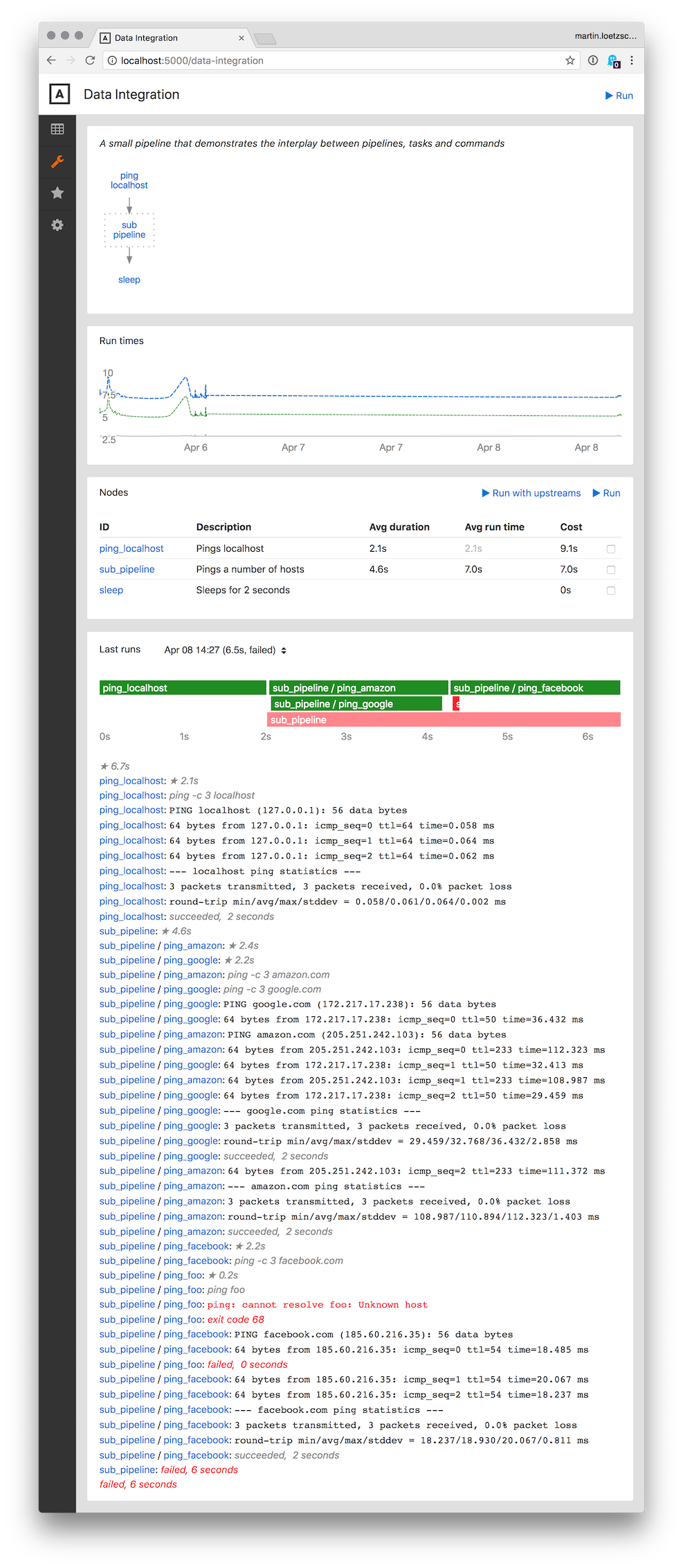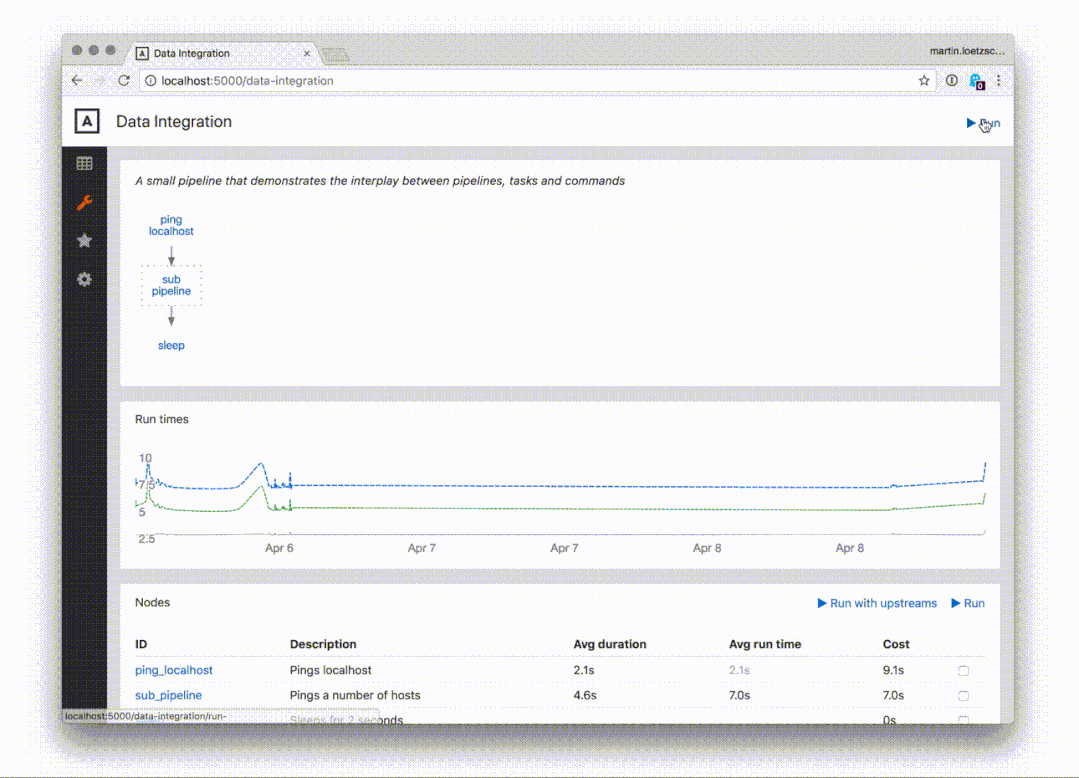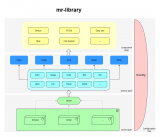Mara-pipelines 是一個輕量級的數據轉換框架,具有透明和低復雜性的特點。其他特點如下:
- 基于非常簡單的Python代碼就能完成流水線開發。
- 使用 PostgreSQL 作為數據處理引擎。
- 有Web界面可視化分析流水線執行過程。
- 基于 Python 的 multiprocessing 單機流水線執行。不需要分布式任務隊列。輕松調試和輸出日志。
- 基于成本的優先隊列:首先運行具有較高成本(基于記錄的運行時間)的節點。
此外,在Mara-pipelines的Web界面中,你不僅可以查看和管理流水線及其任務節點,你還可以直接觸發這些流水線和節點,非常好用:
1.安裝
由于使用了大量的依賴,Mara-pipelines 并不適用于 Windows,如果你需要在 Windows 上使用 Mara-pipelines,請使用 Docker 或者 Windows 下的 linux 子系統。
使用pip安裝Mara-pipelines:
pip install mara-pipelines
或者:
pip install git+https://github.com/mara/mara-pipelines.git
2.使用示例
這是一個基礎的流水線演示,由三個相互依賴的節點組成,包括 任務1(ping_localhost), 子流水線(sub_pipeline), 任務2(sleep):
# 注意,這個示例中使用了部分國外的網站,如果無法訪問,請變更為國內網站。
from mara_pipelines.commands.bash import RunBash
from mara_pipelines.pipelines import Pipeline, Task
from mara_pipelines.ui.cli import run_pipeline, run_interactively
pipeline = Pipeline(
id='demo',
description='A small pipeline that demonstrates the interplay between pipelines, tasks and commands')
pipeline.add(Task(id='ping_localhost', description='Pings localhost',
commands=[RunBash('ping -c 3 localhost')]))
sub_pipeline = Pipeline(id='sub_pipeline', description='Pings a number of hosts')
for host in ['google', 'amazon', 'facebook']:
sub_pipeline.add(Task(id=f'ping_{host}', description=f'Pings {host}',
commands=[RunBash(f'ping -c 3 {host}.com')]))
sub_pipeline.add_dependency('ping_amazon', 'ping_facebook')
sub_pipeline.add(Task(id='ping_foo', description='Pings foo',
commands=[RunBash('ping foo')]), ['ping_amazon'])
pipeline.add(sub_pipeline, ['ping_localhost'])
pipeline.add(Task(id='sleep', description='Sleeps for 2 seconds',
commands=[RunBash('sleep 2')]), ['sub_pipeline'])
可以看到,Task包含了多個commands,這些 commands會用于真正地執行動作。
而 pipeline.add 的參數中,第一個參數是其節點,第二個參數是此節點的上游。如:
pipeline.add(sub_pipeline, ['ping_localhost'])
則表明必須執行完 ping_localhost 才會執行 sub_pipeline.
為了運行這個流水線,需要配置一個 PostgreSQL 數據庫來存儲運行時信息、運行輸出和增量處理狀態:
import mara_db.auto_migration
import mara_db.config
import mara_db.dbs
mara_db.config.databases
= lambda: {'mara': mara_db.dbs.PostgreSQLDB(host='localhost', user='root', database='example_etl_mara')}
mara_db.auto_migration.auto_discover_models_and_migrate()
如果 PostgresSQL 正在運行并且賬號密碼正確,輸出如下所示(創建了一個包含多個表的數據庫):
Created database "postgresql+psycopg2://root@localhost/example_etl_mara"
CREATE TABLE data_integration_file_dependency (
node_path TEXT[] NOT NULL,
dependency_type VARCHAR NOT NULL,
hash VARCHAR,
timestamp TIMESTAMP WITHOUT TIME ZONE,
PRIMARY KEY (node_path, dependency_type)
);
.. more tables
為了運行這個流水線,你需要:
from mara_pipelines.ui.cli import run_pipeline
run_pipeline(pipeline)

這將運行單個流水線節點及其 ( **sub_pipeline ** ) 所依賴的所有節點:
run_pipeline(sub_pipeline, nodes=[sub_pipeline.nodes['ping_amazon']], with_upstreams=True)
3.Web 界面
我認為 mara-pipelines 最有用的是他們提供了基于Flask管控流水線的Web界面。
對于每條流水線,他們都有一個頁面顯示:
- 所有子節點的圖以及它們之間的依賴關系
- 流水線的總體運行時間圖表以及過去 30 天內最昂貴的節點(可配置)
- 所有流水線節點及其平均運行時間和由此產生的排隊優先級的表
- 流水線最后一次運行的輸出和時間線

對于每個任務,都有一個頁面顯示
- 流水線中任務的上游和下游
- 最近 30 天內任務的運行時間
- 任務的所有命令
- 任務最后運行的輸出

此外,流水線和任務可以直接從網頁端調用運行,這是非常棒的特點:

-
數據轉換
+關注
關注
0文章
90瀏覽量
18278 -
代碼
+關注
關注
30文章
4905瀏覽量
70886 -
python
+關注
關注
56文章
4829瀏覽量
87119
發布評論請先 登錄
一個面向嵌入式系統的輕量級框架
輕量級的ui框架如何去制作
Dllite_micro (輕量級的 AI 推理框架)
一種超輕量級的flashKV數據存儲方案分享
原創分享:自制輕量級單片機UI框架

基于非常簡單的Python代碼就能完成流水線開發
測評分享 | 如何在先楫HPM6750上運行輕量級AI推理框架TinyMaix

輕量級數據庫有哪些
一個輕量級的權限認證框架:Sa-Token

基于Python 輕量級ORM框架

深度詳解嵌入式系統專用輕量級框架設計





















評論